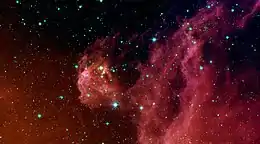Barnard 30
Barnard 30 is a dark cloud in the Lambda Orionis ring, north of Lambda Orionis, also called Meissa.[3] The region is about 1300 light years from Earth.[2]
| Molecular cloud | |
|---|---|
| dark nebula | |
 Barnard 30 seen by the Spitzer Space Telescope | |
| Observation data: J2000.0[1] epoch | |
| Right ascension | 05h 30m 18.0s[1] |
| Declination | +12° 46′ 00″[1] |
| Distance | 1300 ly (400[2] pc) |
| Constellation | Orion (constellation) |
| Designations | Barnard 30 |
The Barnard 30 cloud is one of the regions in the Lambda Orionis Ring where the population of young stars is concentrated, together with the Lambda Orionis cluster and Barnard 35.[4] It contains Herbig-Haro Objects, young stars, brown dwarfs and multiple T Tauri stars. The young population includes HK Orionis, a Herbig Ae/Be star and HI Orionis, a T Tauri star.[2][5]
The stellar population in Barnard 30 is about 2-3 million years old and is therefore significantly younger than the central Lambda Orionis cluster. This cloud is likely shaped by the massive star Meissa and this star is also responsible for triggering star-formation in this cloud. A possible supernova 1 million years ago that possibly has formed the Lambda Orionis ring might be an additional trigger for the star-formation in this region.[6][4]
The region contains a reflection nebula.[7]
Observations
The emission region associated with Barnard 30 has a low surface brightness and covers a large region of the sky. Because Barnard 30 shares the same constellation as the famous Orion Nebula it is rarely imaged.[8]
References
- "Barnard 30". SIMBAD. Centre de données astronomiques de Strasbourg. Retrieved 2020-02-15.
- Huélamo, N.; de Gregorio-Monsalvo, I.; Palau, A.; Barrado, D.; Bayo, A.; Ruiz, M. T.; Zapata, L.; Bouy, H.; Morata, O.; Morales-Calderón, M.; Eiroa, C. (January 2017). "A search for pre- and proto-brown dwarfs in the dark cloud Barnard 30 with ALMA". A&A. 597: A17. arXiv:1712.06400. Bibcode:2017A&A...597A..17H. doi:10.1051/0004-6361/201628510. ISSN 0004-6361.
- "Young Stars Emerge from Orion's Head". NASA Spitzer Space Telescope. Retrieved 2020-02-15.
- Dolan, Christopher J.; Mathieu, Robert D. (January 2002). "A Photometric Study of the Young Stellar Population throughout the λ Orionis Star-Forming Region". AJ. 123 (1): 387–403. Bibcode:2002AJ....123..387D. doi:10.1086/324631. ISSN 0004-6256.
- "HK Orionis". SIMBAD. Centre de données astronomiques de Strasbourg.
- Barrado, D.; de Gregorio Monsalvo, I.; Huélamo, N.; Morales-Calderón, M.; Bayo, A.; Palau, A.; Ruiz, M. T.; Rivière-Marichalar, P.; Bouy, H.; Morata, Ó; Stauffer, J. R. (April 2018). "Early phases in the stellar and substellar formation and evolution. Infrared and submillimeter data in the Barnard 30 dark cloud". A&A. 612: A79. arXiv:1712.06399. Bibcode:2018A&A...612A..79B. doi:10.1051/0004-6361/201527938. ISSN 0004-6361.
- "[RK68] 25". SIMBAD. Centre de données astronomiques de Strasbourg.
- Metsavainio, J.-p (2011-03-15). "Barnard 30, B30, project finalized". Astro Anarchy. Retrieved 2020-02-15.